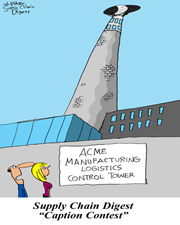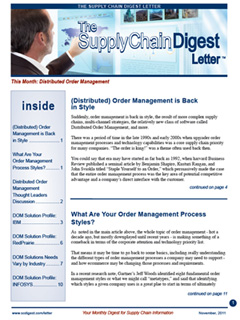 |
November 17, 2011 - Supply Chain Newsletter |
 |
This Week In SCDigest
FEATURED SPONSOR: Seagull Scientific |
For easy, codeless, integration of barcode |

California Cap and Trade - New DetailsAs we cruise into a short Thanksgiving Holiday week here in the US and Canada, I am going to offer a second look at the newly announced specifics for California's cap and trade carbon emissions program. I first reported on this a couple of weeks ago, but promised then some more details soon. I have subsequently done some more research and now want to add some new details to what I had written previously (See Cap and Trade - It's Here). First, I am going to state some of my opinions relative to what is going on here and what level of impact it may have. 1. There is something somewhat amiss. Just meaning, I can't in some cases square some of the predictions for a relatively small cost impact on consumers and businesses with achieving the goals the state has set. 2. I would encourage you to be a bit jaundiced when talking to so-called cap and trade experts. I have talked to several over the last two weeks, and while I have had a few decent conversations, most had a very shallow level of knowledge on the program's details and impact. How will this likely affect gas prices, for example? No one can tell me, despite that being the critical question (More below). 3. I have some concern that some of the state materials on this program and the answers you get back from questions are intentionally vague or obfuscated. 4. The cost impact can only be estimated based on assumptions about what the price of allowances will be in the future as they are traded on some type of exchange. Here, as with other cap and trade programs or concepts across the globe, the estimates are all over the map.
Before some new details from my research, a quick summary of this program. In 2006, California passed what is commonly referred to as AB32. That mandated in part that California reduce the state's total greenhouse gas/CO2 emissions to 1990 levels by 2020 - a very ambitious goal. After much political wrangling, late last month, the state's Air Resources Board (ARB) released the program details, which is based on a cap and trade program. In the first phase, some 650 manufacturing and utility sites will be included in the program - any site emitting more than 25,000 metric tons of carbon per year. Potentially more impactful, in 2015 fuel distributors (refineries, fuel wholesales and such) will be brought into the program. That means every business and consumer will feel the effects. Each party will have limits set based on current emissions. Those limits will be reduced 2% per year at first and then 3% per year through 2020. To comply with the rules, companies will have to reduce their emissions at a site by that amount, and have the level of their emissions independently verified. If emissions are above these set levels, companies must purchase "allowances" to make up the difference in an open market or exchange. Companies that are operating below their threshold can in turn sell their extra allowances and make a profit. Up to 8% of total emissions can also be "offset" with certain types of projects (e.g., tree planting), but they must be in the US, not Brazilian rain forests. So here is the important thing: a paper mill or chemical company may be able to reduce its CO2 emissions through process improvement, new technology, or other means. ARB tells me they do not think it will be much of a burden for most of these manufacturing and utility locations to find a way to reduce emissions 2-3% per year. But it seems to me growth could be a big problem. Meaning, if a company's volume grows 10% this year, the limit still the previous year minus 2-3%. That means the effective reduction level burden is something a lot more than 2-3%, but probably not a full 12% (10% +2% ) because there would be fixed and variable CO2 components at most factories. Still, it makes the growth somewhat less profitable than it would otherwise be, as there is a new carbon cost to the incremental sales. But now consider a fuel distributor. There, the CO2 measure is not an operational one, but rather a direct measure of how much fuel (gas, diesel, etc.) the distributor is pumping. In this sense, it is closer to a carbon tax mentality (tax the source of the carbon). As its permitted allowances drop each year (and again consider a growth factor), the distributor cannot reduce their own emissions through process/technology improvement. It can only reduce them by pumping less fuel - or buying more and more allowances to make up the difference. And that might get pretty expensive. Said an ARB spokesperson to me last week: "Yes, the explicit goal is to make fossil fuels a lot more expensive so that consumers and businesses use less of them." But how much more expensive? Well, that depends on how much allowances ultimately wind up costing in the exchange. I have seen calculations guessing as low as 8 cents a gallon for regular gas and diesel to 80 cents or so. That's quite a range. At the low end, to my first bullet point at the top, I think it would have negligible if any impact on gas/diesel consumption. At the high end, there is obviously a substantial impact to consumers, truckers, and shippers. And no one really knows. Other new facts I have learned: • The 650 sites under the program have been reporting emissions for three years, and having those verified for two. As of now, there are no plans in place to bring more factories into the program by dropping the threshold below 25,000 tons of emissions. The threshold is site specific - a company could have 20 sites each doing 20,000 tons, and they would not be part of the program. • Site will therefore to an extent move in and out of the program. Drop below 25K and you are done with it. • A verification process is relatively cheap. They are based on defined "protocols" for measuring emissions in different sectors, and cost for now just $3-4,000 each. Developing an initial plan, process and measuring system will be a large effort for many companies though. • Companies will initially get 90% of the year's allowances for free. They will have to buy 10% in the exchange. An exception will be companies in some sectors deemed at risk from imports, which will get all their allowance for free so they are not at a cost disadvantage. • A company can acquire allowances at any time - say when they seem cheap - and bank them for future use or sale indefinitely. • The state will keep a "safety valve" level of some 4% of the total allowances it will sell into the market at a defined price if shortages come up and the price in the exchange begins to skyrocket. There's more, but that's it for now, The wild card here it seems to me is the consumer. No one cares what truckers pay for fuel - though they should - but if gas prices rise a lot, so that it is even more expensive in California then the rest of the country, I would think you would see things get pretty testy even in the Golden State. Did this help you clarify the impact and details of the California cap and trade law? What else would you like to know? How do you see this playing out? Let us know your thoughts at the Feedback button below.
|
|
New Videocast:
|
On-Demand Videocast
|
New SCDigest Letter on Distributed Order Management Subscribe Now to Ensure You Receive a Mailed Hard Copy Mailing in a Few Days
|
Just a few quick letters, courtesy from our partners at RetailWire, on our recent piece on accusations of poor working conditons at an Amazon.com DC.
Feedback of the Week: On Amazon DC Conditions:
After many dealings with Amazon, this is a difficult article to believe...although it may indeed be true; the actual question is how much of the "hearsay" is valid and how much is subjective? Many of the quotes are very dubious about the true importance here; Amazon is already reacting and putting A/C in their warehouse. Whether these efforts are sufficient is another story. As a manufacturing president, who has installed A/C to keep the entire warehouse cool, determining effectiveness and employee comfort are often 2 different sides of the same coin. DCs are often in poor condition regarding temperature, but this is not unexpected when working in a DC compared to an office or another environment. Perhaps the true measure of this would have been to include interviews with the A/C companies who installed the units to get their perception on the units installed in these warehouses compared to other warehouses they have done over the years. Hmmmm.... Kai Clarke President Miraclebeam Products, Inc. -------------------------------------------------------------------------------- |
||
More on Amazon.con DC Conditions:
|
||
DCs are a rough work environment. Anyone who thinks that it's easy in a DC isn't working in a busy and efficient DC. As for the heat, etc, it looks like Amazon is taking the steps necessary to fix the problem but I don't agree with the hiring of temps. While they may save money in the short term, Amazon has go to know that it is costing them to hire, train, fire and rehire, and retrain temps. Plus I question the overall quality of work and commitment by temps. Doron Levy -------------------------------------------------------------------------------- |
||
| Working in a DC is not an easy job to begin with. In this case, I am led to wonder what took so long for it to surface if paramedics had previously had to bring people out in wheelchairs. It appears Amazon got caught with their best face reddened. I also think this will pass quickly. Amazon has too good a name to allow it to linger. They will make the needed changes.
Ed Rosenbaum CEO The Customer Service Rainmaker |
||
| Without a thorough, impartial investigation, it's hard to know what really went on there. If this was a union shop, it's hard to believe this was as bad as it says, unless the union steward was being paid off by management. But it's hard work, as Doron said. When I was a kid I worked in a retailer DC that was roughly as described here. If the union steward didn't like you, you got a "mule job" that was so hard it was designed to break you. Never can forget the day a guy dropped dead and a boss came over, covered the guy with a big cardboard box, and told us to stop looking and get back to work. Not making that one up, folks. Warren Thayer |
||
I am not defending Amazon, but are the work conditions any different than the factories across the country? (Or maybe I should say those that remain.) I commend Amazon for adding the AC units.
Doug Fleener
|
SUPPLY CHAIN TRIVIA ANSWER
Q: In 2001, Ralph Drayer was the last winner of CSCMP's Distinguished Service Award (then CLM) that was what?
A: Drayer, VP of logistics at Procter & Gamble, was the most recent - and one of the few ever – to receive the honor while still a practitioner in supply chain in a regular business (not an academic, consultant, 3PL, software vendor, etc.). Lee Scott of WalMart, a former logistics executive there, won the DSA in 2003, but he was CEO at WalMart by that time.
| © SupplyChainDigest™ 2003-2011. All Rights Reserved. SupplyChainDigest PO Box 714 Springboro, Ohio 45066 |
POWERED BY: XDIMENSION |







